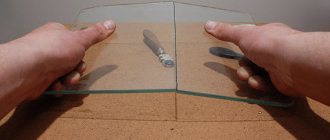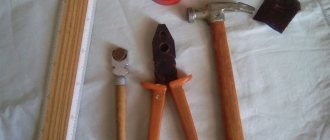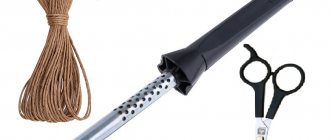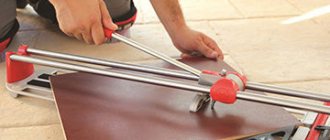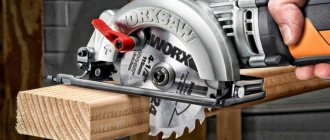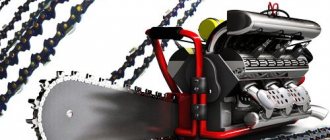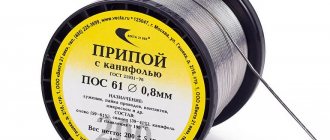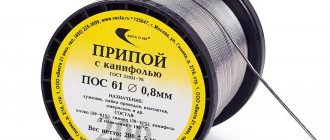How and what to fill and how to work with an oil glass cutter?
The oil glass cutter has relatively recently appeared in the arsenal of glass cutters. In principle, this is the same roller glass cutter, equipped with the function of automatically supplying lubricant to the cutting element. The oil reservoir is combined with the handle of the glass cutter, and the liquid flows through the wick directly to the roller, simultaneously lubricating its axis.
This system makes it possible to reduce friction in the roller axis, ensuring its smooth movement, and binds the smallest particles of glass that are formed during the cutting process.
In order for an oil glass cutter to work correctly, it must be filled with special oil. This oil has one important feature - it is washed off with water!, and in addition, it does not flow from the roller axis and the roller itself and does not spread on the glass.
Of course, instead of special oil, you can use other types of oils, including spindle oil, as long as it has fluidity that can be freely supplied through the wick to the cutting element. You can use turpentine, kerosene, white spirit, etc.
But such a replacement is extremely undesirable because:
firstly, as mentioned above, all these substances are difficult to remove from glass. You will have to allocate additional time and money to purchase special liquids to clean it from grease stains.
secondly, the use of such substitutes will render your instrument inoperable in a very short time.
Special oils used for oil glass cutters:
Silberschnitt, Milli M2000, T-3133, BOHLE, EnviroGOLD, Novacan Cutter Oil, etc.
Oil is poured into the reservoir handle to 2/3 of the full volume. To ensure that the oil flows evenly and correctly during operation, its flow is regulated using a cap. By turning the cap in one direction or the other, you ensure that you get an even and wet strip on the glass. At the end of the work, if a long break is not expected, the oil can be left in the glass cutter, otherwise it is better to drain the oil.
The basic techniques for cutting and preparing material when working with an oil glass cutter are the same as with a diamond one. (See here, on RemOtvet).
And finally, a short video on the topic.
An oil glass cutter is not much more difficult to use than a regular roller cutter. The principles of handling them are the same, with the only difference being that an oil glass cutter (as the name implies) also has a supply of lubricating fluid to the cutting site.
What to fuel. The most budget-friendly option for a lubricant for an oil glass cutter is motor oil diluted with regular kerosene in a one-to-one ratio. Anyone can make this kind of lube. Oil with kerosene has a lower viscosity due to which it penetrates the roller and at the same time does not lack lubricating properties. Engine oil with kerosene does not affect the life of the roller in any way, nor does it affect the quality of the cut. The only disadvantage of such a cocktail is that it is more difficult to wash with water.
Special oils for oil glass cutters are no better in their lubricating properties than oil diluted with kerosene, but they are several times more expensive. Their undeniable advantage is that they are water-soluble and wash off well, because they consist of heavy esters with an oily consistency. If you nevertheless made a choice in favor of a special product for an oil glass cutter, then T-3133 oil, made in Russia, is quite suitable as it. The price for two hundred grams is no more than 250 rubles. For a home craftsman, this jar will last for ten years. It washes off without leaving streaks. From abroad there is a good liquid SOGEVER 1000 FG. This one does not require rinsing at all, it evaporates completely on its own. True, it costs about five thousand per liter. I didn't see it in a small container. Mainly used for automatic glass cutting and critical glass contour cutting (wave cutting) work.
How to work? An oil glass cutter, unlike a roller (dry) or diamond cutter, requires a minimum of preparatory work - just pour lubricating fluid into the handle of the tool.
The rules for cutting with an oil glass cutter are the same as for others - the glass must be clean, laid on a flat, hard surface. Before the end of the cut, release the pressure. You can’t make one cut several times—you’ll ruin the roller. Glass with a thickness of more than 5 millimeters must be cut on both sides, two cuts opposite each other.
How to use oil when cutting glass with a glass cutter
We have already written about how much oil to fill the glass cutter handle. It is important that the oil flows onto the cutting part evenly without unnecessary smudges, but nevertheless still comes out of the container. Make the adjustment by turning the filling cap, turn it to a certain degree and run the glass cutter along the glass. You should get a smooth cut line that is moist with oil. If necessary, adjust by tightening or unscrewing the cap. When you are not using the glass cutter, tighten the cap to prevent oil from leaking out.
Read also: How much does a full 50 liter gas cylinder weigh?
Which glass cutter is better, a roller cutter or an oil cutter?
Some of the most affordable glass cutters are oil cutters and regular roller cutters. These glass cutters are quite suitable for household needs and they are very popular due to their low cost. Their price category is approximately the same and ranges from 200 to 300 rubles.
Last time I told you in detail how to cut glass correctly
, today we will discuss
which glass cutter is better, oil or roller
, considering their advantages and disadvantages. This article, first of all, will be useful for those who are not involved in professional cutting and, one might say, will be holding a glass cutter in their hands for the first time. But perhaps people with experience will also learn something useful for themselves.
First, let's look at the difference between a roller glass cutter and an oil glass cutter. And let's start with the roller.
Regular roller glass cutter
has a simple design: a plastic or wooden handle, a metal part with grooves that are used to break glass, and the main element - a roller (disk). These glass cutters can have up to 6 rollers. When one roller becomes dull, it is easy to replace it with another by unscrewing the drum. The resource of one cutting element is from 500 to 1000 m.
It was with this glass cutter that I began to master cutting glass and, to put it mildly, it was not an easy task, but more on that later.
How to break glass correctly
Usually thin glass is broken by hand. Place the cut glass on the edge of the table, so that the cutting line is on top and slightly protrudes beyond the edge of the tabletop, and most of the glass lies on the tabletop. With one hand, press the glass onto the table, and with the other, grab the glass by the half protruding from the table. Then use your other hand to gently press down on the glass.
If the edge to be broken off is too small and there is nothing to grasp with your hand, then break off the glass with pliers. Take the pliers so that the edge of their lips is on the cut line, lightly squeeze the glass and gently press the handles down. Usually it is not possible to break off the cut strip entirely with pliers, so several such approaches will be needed.
Knowing theoretically how to cut glass, take some unnecessary glass and practice on it to get a feel for the tool and get your hand a little better. And then, if you have to cut glass, your hand itself will remember both the required position of the glass cutter and the required pressure.
Oil glass cutter
An oil glass cutter is one of the most popular tools for cutting glass. This is explained by its ease of learning and use, as well as its low cost. This type occupies a middle position between the most economical, but limited in cutting capabilities, roller glass cutters and the more expensive and difficult to operate, but professional diamond ones. Its power is enough for home use and small industries, which makes it the best choice when purchasing in the vast majority of cases.
Reviews of Toyo models
Inexpensive but high-quality models that are suitable for use at home. As users note, some versions from this line have one nuance. Glass cutters do not work effectively with oil, but without it they can easily handle even thick glass. In terms of ergonomics, there are no complaints. The simple design makes the device easy to use. There are also operational features that this oil glass cutter has. Reviews emphasize that it is better to dip the head in oil - this will increase ease of use and increase the quality of the cut. In terms of reliability, Toyo models are difficult to compare with professional modifications, but the combination of impact-resistant plastic and a damage-resistant head gives every reason to count on the durability of the tool.
Oil glass cutter device
In its design, an oil glass cutter is similar to a conventional roller cutter and, in fact, this is only the next step in the evolution of this device for cutting glass.
The working body is a disk made of tungsten or cobalt alloy. Such chemical compounds are characterized by increased hardness and are widely used in the creation of cutting tools.
The roller is fixed on a metal holder, the connection is designed so that it can rotate freely around its center, but at the same time, deviations to the sides during movement are minimal, and an even, neat cut remains behind the tool on the glass. The working head of the oil glass cutter is made monolithic, so that when the service life of the cutting disk is exhausted, it is completely replaced. The standard package includes two tips; the rollers on them differ in sharpening angle: 135º and 150º. The first is suitable for cutting glass up to 10 mm thick, the second - for thicker ones.
The handle of the oil glass cutter contains a built-in container for lubricant and a mechanism for supplying it to the working head. This device differs significantly from dry roller cutters. The liquid entering the working area reduces the friction forces arising during operation, increasing the service life and reducing the formation of microcracks.
Features of choosing oil for a glass cutter
Glass cutters of this type are equipped with an oil tank. The oil supply made the design of the tool a little more complex, because, for example, diamond analogues did not require the use of lubricant. However, modern glass cutters that use oil during operation are noticeably ahead of their diamond counterparts both in terms of service life and cut quality. You just need to know how to choose quality oil.
Modern glass cutters that use oil during operation are noticeably superior in quality and convenience to their diamond counterparts.
To choose a good lubricant, do your research carefully before purchasing. High-quality oil must meet the following requirements:
- Have such a consistency that it can easily penetrate into the lubricant supply channel.
- Have suitable adhesion, do not run off the roller and its axis, and do not spread over the workpiece.
There are only 2 basic requirements, but not all oils meet them. An incorrectly selected viscosity will soon result in the glass cutter head being lost. Therefore, it is better not to save, especially since you won’t be able to save too much anyway. Even a small 200 gram package will last you for a long time.
You can check the quality of the oil immediately using a glass cutter. To do this, pour the lubricant into the appropriate reservoir, and then lightly press the tool head against the glass so that the lubricant passes to the roller. High-quality oil will flow down the roller onto the workpiece and leave behind an extremely small round spot.
How to choose an oil glass cutter
When choosing an oil glass cutter, pay attention to the following things:
- The tool purchased must be suitable for the intended job. Oil glass cutters cut glass up to 20 mm thick; thicker sheets are processed on special laser or hydraulic machines.
- The cutting roller should sit securely in the holder, the gap between them should be minimal. This design will reduce the movement of the cutter to the sides when cutting.
- An important point is the ease of grip, which is ensured by the corrugated surface of the handle and the polymer coating.
A normal requirement would be to ask the seller to demonstrate the operation of the tool. During the test, make sure that the cut line is thin and even. And also during the cutting process there should be no extraneous squeaking.
What kind of oil to pour into a glass cutter
Kerosene, white spirit, turpentine, Vaseline solution and other liquids can be used as a lubricant for a glass cutter. However, their use is associated with additional inconveniences: strong odor, greasy marks on the glass surface, and reduced service life of the instrument. Oils with high viscosity, such as machine oil, will cause the greatest harm to the glass cutter, so their use is highly undesirable.
Therefore, it would be more correct to use compounds specially designed for oil-based glass cutters. Here are some names: T-3133, Milli M2000, BOHLE, Novacan Cutter Oil, Silberschnitt, Acecut 5503. Glass cutter fluid has optimal fluidity and does not create puddles on the glass.
Another important advantage is that they are washed off without residue with plain water. Due to its viscosity, glass cutter oil is supplied to the working area at the required speed.
Guide to action
When the surface and material are prepared, you can begin to work.
When cutting glass for the first time, the main thing is not to worry.
Safety is more important than results.
In addition, the calmer you cut, the smoother and smoother the cutting line will be. It is important to follow this sequence:
- The first step is to mark the glass. To do this, you can use a folding meter, ruler or tape measure. Leave marks on the glass with a marker or felt-tip pen, which leaves a thin line, so the result will be more accurate.
- It is also better to guide the glass cutter along a ruler. Remember that the ruler must be thick enough so that the cutter does not jump off when pressed and does not leave unnecessary cracks or scratches.
- Taking the glass cutter in your working hand, hold the glass with the other so that they do not move.
- Different types of glass cutters are tedious to hold in their own way. Apply light pressure and at the same time smoothly move the glass cutter along the entire cutting line.
- Cutting must be carried out in one motion. If you have lost the pressure, there is no point in going through this place twice; it can only make things worse.
- After the cutting line is drawn, you need to break off a piece of glass. To do this, the entire sheet is moved to the edge so that the separated part hangs in the air. Grab the edge of the glass and, with a gentle but firm movement, break it down.
- The sharp edge at the breaking point can be ground with a fine diamond file or needle file. The main thing is not to put in a lot of effort.
- If there are small pieces left that violate the geometry of the cut, you can try to break them off with pliers. Roller glass cutters have grooves in which, by inserting a piece of glass and pressing like a lever, you can remove small irregularities.
This sequence of actions has nuances if you use a certain type of glass cutter.
How to use a roller tool?
The roller glass cutter must be held strictly perpendicular to the surface of the glass being cut. The roller must cut with an edge, otherwise the cut will be less deep. You should also not tilt the tool towards or away from you - losses will occur due to the applied force.
The pressure with which you need to move the roller glass cutter along the line should not be very large, but not small either. You shouldn’t lean on the glass, but driving the video without applying force is a waste. When cutting, you should hear a slight constant cracking sound, this is a sign of normal line progress.
How to use an oil tool?
Since the working cutter in an oil glass cutter is also a roller, it is held in the same way as a roller. The pressure should also be sufficient. The advantage of an oil glass cutter is the lubricant that comes from the corresponding compartment in the handle. Professional tools use special lubricant. You can replace it with different substances, for example, fill it with spindle oil. Volatile liquids also work well: kerosene, white spirit. It is better not to use edible or car oil - it is too thick and viscous.
With the proper skill, lubrication prolongs the life of the roller in an oil glass cutter by tens of times compared to dry cutting.
How to use a diamond tool?
The diamond glass cutter differs from the previous ones in that it has no moving parts. The diamond cutter is rigidly fixed in the metal base of the tool. When cutting, the diamond glass cutter is held at an angle to the surface, with a slight inclination towards you. You need to apply less pressure on a diamond glass cutter than on a roller or oil cutter, so the comfortable grip is the same as when holding a fountain pen. The line remaining behind the cutter should be thin and colorless.
Helpful tip: Before breaking the glass, tap it on the back side with the handle or metal head of the glass cutter. You need to knock carefully, then you can see how an even crack spreads along the cut line throughout the entire thickness of the glass. After this, it will be much easier to break the remaining piece
Different types of glass and rules for working with them
Cutting the most common silicate glass up to 10 mm thick is usually not difficult. However, the material called glass has several variations in its chemical composition, production methods and design of the sheet itself. This is certainly worth taking into account when working.
- Triplex. Consists of several layers of glass alternating with a protective film. The material is used where there is a high probability of mechanical damage, and the scattering of fragments is unacceptable, for example in cars. At home, cutting triplex is difficult, especially if it contains more than one film inside.
- Strained glass. The material produced using this technology is stronger and harder, so working with it at home should be avoided. If the specified properties for glass are necessary, you can initially cut standard silicate glass and then send it for tempering.
- Plexiglas and acrylic. A fairly soft material that any glass cutter can handle, as well as files, knives, etc. Plexiglas is lightweight and has good impact resistance, in other words, it does not break.
- Glass with grooves and patterns. One side of this glass has a pattern in the form of embossing or a pattern. It is most often used to create decorative interior elements. Glass is cut from the smooth side. The standard thickness is 4 mm, patterned glass is easy to process.
- Mirror. There is no fundamental difference in processing from standard glass, except that it needs to be cut from the side where there is no reflective film.
Preparing the workbench and glass for cutting
Glass is quite easy to process; you just need to follow a number of simple rules. If you have never used an oil glass cutter before, start training by preparing your work surface. The surface must be such that no vibrations are created during operation. In addition, there should not be any irregularities on it.
To cut glass, you need to have a glass cutter and a ruler. You should wear safety glasses when working.
A simple desktop does not always meet these requirements: it has probably been repeatedly knocked on, it has been exposed to moisture, etc. Therefore, it is better to immediately prepare ordinary fiberboard. It costs a penny. Place it on the table and all the irregularities will disappear.
To work you need a minimum of tools:
- Glass cutter.
- Ruler.
- Protective gloves and glasses.
Before you start working with an oil glass cutter, you need to properly prepare the glass. New glass should be thoroughly cleaned from dirt and dust using a cloth. Old workpieces, as a rule, have to be washed, because... existing stains usually cannot be cleaned with just a piece of cloth. You can wipe the glass with ordinary newspaper - this is the simplest, most affordable and effective way.
Read also: Potential energy of a spring in a gravitational field
After washing, it is recommended to degrease the surface. This can be done using ordinary turpentine or alcohol. After this, the glass must be left until it dries.
Glass cutting technology.
While working you will need an auxiliary ruler. In addition, experienced craftsmen use another effective technique: they outline the working surface on which the glass will lie. The material is transparent, and during operation you can see exactly where it needs to be cut. Draw such a thick line too. Then take a glass cutter and make marks on the glass. Draw 2 small lines at the start and end of the cut line.
After this, place the workpiece on the glass so that the applied marks are located parallel to the line that you previously made on the table. There should be a distance of 2-4 mm between them. Press the ruler firmly onto the surface of the glass. Be sure to make sure that she is not fidgeting before you start cutting.
Safety precautions when working
The greatest dangers when cutting are the sharp edges of glass sheets and microscopic fragments formed during the work. Inexperienced craftsmen have a high risk of injury and bruises.
To prevent accidents, all work is carried out wearing protective glasses and gloves. Compliance with the established cutting technology helps to avoid accidental sheet bending and chipping. The basic rule here is that the glass cutter always passes along the intended line only once; if a cutting defect is detected, the operator retreats a short distance and makes a new attempt. It is customary for two people to work with large sheets; this greatly simplifies the transfer of fluid and its breaking; in production, workers learn to act harmoniously for greater efficiency and reduce the risk of injury.
It is very important to keep your work area clean and tidy. The fragments are sent to a special box. After work, the table is wiped clean of glass dust. If ingested, it can damage the esophagus and lungs, and contact with the mucous membrane of the eyes can cause a difficult-to-heal injury. Broken furniture with cracks, poorly secured legs, etc. cannot be used as a desktop.
Features of using an oil glass cutter
An oil glass cutter has several differences from a roller cutter and a diamond cutter, some of which can be attributed to advantages, and some to disadvantages.
- When the cutting element interacts with the material, fewer microcracks and glass dust appear.
- This type of tool can cut more than 5000 m of glass. With careful handling and regular oil changes, the service life increases even more.
- Working with an oil glass cutter requires less physical effort from the operator, which, combined with a long service life, makes it more suitable for constant work.
- Thanks to lubrication, the quality of the cut improves.
- On average, cheaper than models with a diamond cutter.
- Cuts glass up to 20 mm thick.
- All people quickly master the oil glass cutter; it is much easier for them to work than a diamond glass cutter.
Types of glass cutters
Tools differ in several categories. According to the design, the glass cutter is:
- diamond;
- roller;
- oil;
- glass cutter compass;
- victorious.
The type of glass cutter is:
- fixed;
- with rotating mandrel.
The cutter can be in the form:
- pointed edge;
- roller
Oil glass cutter
One of the most popular tools for cutting glass. A special feature is the presence of a small reservoir for oil, which is supplied to the cutting element automatically during operation. It is located in the handle, which has finger ridges for comfortable holding. When understanding what types of glass cutters there are, you need to know that oil cutters can work on glass up to 20 mm thick. When used, a lubricant is supplied from the reservoir, which reduces friction and wear on the cutting part.
In addition, due to the viscosity of the oil substance, small particles of cut material are collected during operation. For home use, use a device with a sharpening angle of 135°. Among the disadvantages, only high cost stands out. The advantages include:
- ability to work with large volumes;
- durability;
- straight cut;
- independent oil supply;
- ease of use.
Diamond glass cutter
This tool works more accurately and accurately than others. Artificial or natural stone can be used in production. The first option can work with thicker glass. The working element is a solid diamond crystal, which comes in two types:
- with a curved cutting edge;
- in the shape of a pyramid.
The first is suitable for beginners, and the second for professionals with extensive experience. A diamond glass cutter is a device that has the following features:
- making a thin cut;
- sensitivity to shock loads;
- the presence of a screw that helps change the working edge.
These glass cutters differ in the size of the stone:
- small up to 0.05 carats for thin-leaved products;
- large 0.11 carats for 10 mm glass.
Among the advantages are:
- creating an even groove;
- high-quality cut;
- durability.
The disadvantages include:
- presence of work experience;
- high cost.
Roller glass cutter
The most common type. The cutting is performed with a rotating roller made of carbide material, such as tungsten carbide or high-speed steel. When researching which glass cutter to choose for glass, you need to know that there are models with one, three and six rollers. The latest products are considered the most durable, and they also allow you to work with large volumes of material. Another plus is the ergonomic handle. It can be presented:
- pencil;
- with a pistol.
In the first option, the pressure falls on the operator’s fingers, and in the second, on the elbow joint. The roller glass cutter can work with glass up to 6 mm thick. Among the positive qualities are:
- low cost;
- ease of use;
- possibility of replacing the cutting element.
The disadvantages include:
- poor groove quality;
- small amount of work.
Compass glass cutter
The best tool for creating holes or shapes in the form of a circle or oval. The circular glass cutter is based on a circular mechanism. The supporting point is a suction cup, which fixes the entire structure on the glass plane. A scale and a cutting element are attached to it, moving along the latter to adjust the radius
For a quality cut, it is important to pre-select the radius on the measuring scales. The advantages of this glass cutter include:
- the ability to cut holes and complex shapes;
- ability to work with thick glass;
- making the tool easier to use.
A glass cutter for thick glass has the following disadvantages:
- the need for operator experience;
- high cost.
Pobedite glass cutter
The cheapest tool option. A fixed pobedit cutter is used as a cutting element. It cannot be categorized as a good glass cutter for glass, but it is suitable for one-time use. Among the advantages are:
- cheapness;
- Suitable for single use.
The disadvantages include:
- the need for constant sharpening;
- poor groove quality;
- not a neat cutting line.
Tips for cutting glass
Experienced craftsmen know how to get a high-quality cut, complete the job with a minimum of waste, etc. And so that beginners make fewer mistakes, we have prepared a small list of recommendations for working with a glass cutter:
- If the mark left by the tool is too wide and there is a lot of dust around the edges, you need to apply less pressure on the glass cutter.
- When breaking glass, it is better to take the unnecessary part over the edge of the table, so that it will break if the operator does not hold it.
- If the glass is thicker than the glass cutter can cut, then cuts can be made on both sides. The main thing is to carefully turn the workpiece over before the second approach and try to ensure that both cuts coincide as much as possible.
- Narrow strips are broken off using pliers.
- After marking the cutting of the glass sheet, it is checked for compliance with the dimensions.
- When it is necessary to cut out a complex shape, the prepared template is glued to the surface of the sheet with wax so that it does not move out.
- The hole in the glass is made with hardened drills. If you don’t have one at hand, you can make it yourself. To do this, the tip of the drill is heated white-hot over an open fire and stuck into the sealing wax. When the resinous substance stops melting, the drill is pulled out and moistened with turpentine. They work with a hand drill, periodically wetting the drill with water or the same turpentine.
- You should not immediately take on figure cutting and complex materials. To begin with, a beginner must gain experience cutting straight on ordinary silicate glass.
- The choice of cutting method depends on the task at hand; besides glass cutters, there are other options and sometimes their use is more effective.
Oil-based models of glass cutters are the most versatile. The increased acquisition costs compared to a simple roller tool are more than offset by ease of use and increased service life.
How to cut (drill) a hole in glass
Small holes are cut only with a diamond core bit or drill. Small glass drill bits can be purchased at the store. Such drills are a tube coated with hard material at one of its ends. Or something resembling a small spear. It is best to drill glass with cooling and lubrication, that is, with water supply.
Read also: Colors of tulips audio video
When drilling, do not press too hard on the glass. Drilling holes is quite easy.
Large diameter holes, more than 80 mm, can only be cut with a glass cutter and only with some experience. Use a glass cutter to mark the outline of the hole. Tap the outline. We draw sectors inside the future hole and also tap.
Next, we place the glass on a mug, jar, no matter what, but in such a way that the diameter of the future hole is minimally less than the diameter of the mandrel on which we placed the glass.
Next, carefully tap out the hole.
The second option is to use a special tool. A suction cup is installed in the center, to which a rod rotating along the perimeter is attached. A glass cutter is installed on the rod. It can be adjusted, thereby setting the desired size for the hole being cut. As a result, the cut turns out smooth, and therefore the chip is neat. This option will be more advantageous than simply cutting through the glass with a glass cutter by hand.
An example of a tool used to cut large diameter holes in glass. If you need to cut a glass tube, say a measuring tube, then you can use an unusual, but quite viable method. It is discussed in the article “How to make a glass from a bottle.”
Oil or diamond glass cutter: which is better?
Often when renovating an apartment or house there is a need to cut glass. The choice of tool with which this procedure is performed depends on the quality of the cut. What kind of glass cutters are there and which one is better to choose? Let's try to figure this out.
Tools are classified according to the type of cutting head and purpose. Among the most commonly used are oil and diamond glass cutters. Each of them has its own advantages, disadvantages and features of use.
Pros and cons of oil glass cutter
The design is distinguished by the presence of a reservoir on its handle into which oil is poured. A wick extends from the reservoir to the cutting head. It automatically supplies oil to the surface of the work surface during cutting. Oil performs several functions simultaneously:
- reduces the level of friction;
- increases the shelf life of the cutting head; The movement of the device on the glass is simplified.
The popularity of the oil device is due to the advantages inherent in it. For example:
- Ease of use.
- The working life reaches 5 thousand linear meters. m. without the need for re-sharpening.
- Ergonomic shape.
In addition to the advantages, this type of device also has some disadvantages. Among them, the most significant is that there is a need to periodically add oil to the reservoir. The lubricant must be of high quality. Otherwise, the cutting quality will decrease.
Pros and cons of a diamond glass cutter
The cutting blade is fixedly fixed to the handle using silver solder. Diamond is used to make the blade. It can be natural, which allows you to work with material with a thickness of 5-10 mm. When using synthetic diamond, the tool can be used to cut surfaces whose thickness is no more than 5 mm.
Diamond has a number of advantages. Among them are the following:
- Possibility of cutting without preliminary marking.
- If the diamond head becomes dull, you can sharpen it yourself or replace it with a new one.
- The design has several (1-3) slots designed to break off the surface.
- The presence of rubberized pads on the handle.
- Possibility of use by both experienced and novice craftsmen.
Its popularity is not inferior to oil. This is due to the fact that its resource reaches 10 thousand linear meters. m.
What's better
The correct choice has a significant impact on the quality of the cut and the ease of cutting. When choosing one of the two types of tools, it is recommended to take into account the thickness of the glass and the professionalism of the craftsman.
If you do not have cutting skills, it is better to give preference to the oil type. This is due to the fact that it is simpler and easier to work with. Its use requires the master to have certain skills.
The thickness of the material also influences the choice. To work with material thicker than 10 mm, it is recommended to opt for a diamond glass cutter. If you need to cut a surface whose thickness reaches 20 mm, it is better to choose an oil type of tool.
The design of the handle is also important. The presence of rubberized pads on it simplifies the work. Thanks to this, the hand does not slip, and the handle fits comfortably in the hand.
Taking into account the design features and operating principles, it is necessary to choose the right type. Thanks to this, it will be possible to simplify cutting and achieve high quality.
